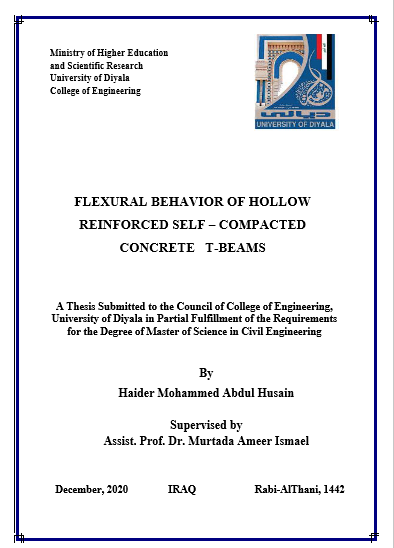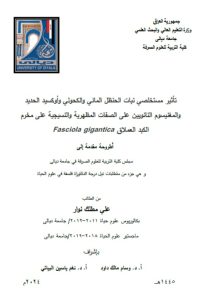Abstract
Hollow-core reinforced concrete beams are the beams which have longitudinal cavities through their entire span. The hollow reinforced concrete beams have many advantages over the solid beams, the longitudinal cavities reduce the concrete amount resulting in reduction in dead loads which means cost-saving, fast construction and getting long-span. Moreover, such cavities are used to pass electrical and mechanical equipment. The abatement of concrete contributes in the sustainability process due to reducing the CO2 emitted.
The present study comprises the implementation of an experimental program to investigate the flexural behavior of hollow reinforced concrete T- beams. The experimental program includes casting and testing thirteen reinforced concrete beams that were casted with dimensions of 250 mm flange width (bf), 75 mm flange depth (hf), web width of 150 mm (bweb) and total height of 300 mm (h) and total length (L) of 2000 mm, twelve of these specimens were hollow reinforced concrete T- beams (HRCTBs) and the other was solid T- beam as a reference specimen. These beams were proposed to study the effect of longitudinal cavities number (one, two and three), longitudinal cavities diameter (25 mm, 32 mm and 50 mm), longitudinal cavities depth (105 mm, 170 mm and 235 mm) and longitudinal cavities geometry (sharp parabolic, normal parabolic and circular) on the structural behavior of hollow reinforced concrete T- beams.
The experimental results showed that the presence of longitudinal circular cavities in HRCTBs has a significant effect on first crack load, while the effect on the yield load and ultimate strength is slight. However, using cavities with number from one to three reduces the first crack load by 7.14 % to 14.27% and ultimate strength between 1.67 % to 3.60% and using cavities with diameter from 25 to 50 mm reduces first crack load by 10.71 % to 17.86 % and ultimate load strength between 1.03 % to 3.60 % .
In addition, it was reported that using cavities with depth changes from 105mm to 235 mm reduces first crack load by 3.57 % to 17.86 % and ultimate load strength between 0.39% to 2.31%. Moreover, the first crack load decreased by 3.57 %, 7.14 % and 7.14 ultimate load strength decreased by 0.26 %, 0.39 % and 1.03 % at using longitudinal cavity of circular shape, normal parabolic and sharp parabolic shape respectively. Furthermore, the presence of circular cavities has a negligible effect on the deflection before 55% from the ultimate load and has effect after that load causing an increase in the yield and ultimate deflection.
The reported ductility factor was reported to be 5.54, 5.68 and 5.66 when one, two and three cavities are existed respectively while 5.53, 5.69 and 5.66 were reported when the diameter of cavity was increased from 25 mm to 32 mm and 50mm respectively. The reported levels were reported as 5.57, 5.61 and 5.6 when the depth of cavity is 105mm, 170mm and 235mm respectively while 5.6, 5.59 and 5.53 were reported as the longitudinal cavity of HRCTBs changes from circular shape to normal parabolic and sharp parabolic shape respectively.
Finally, using the hollow reinforced concrete T – beams can reduce the raw materials weight to 12 % with cost saving up to 8%, additionally, using the hollow reinforced concrete T- beams can reduce the CO2 emission and the embedded energy by about 12%.




